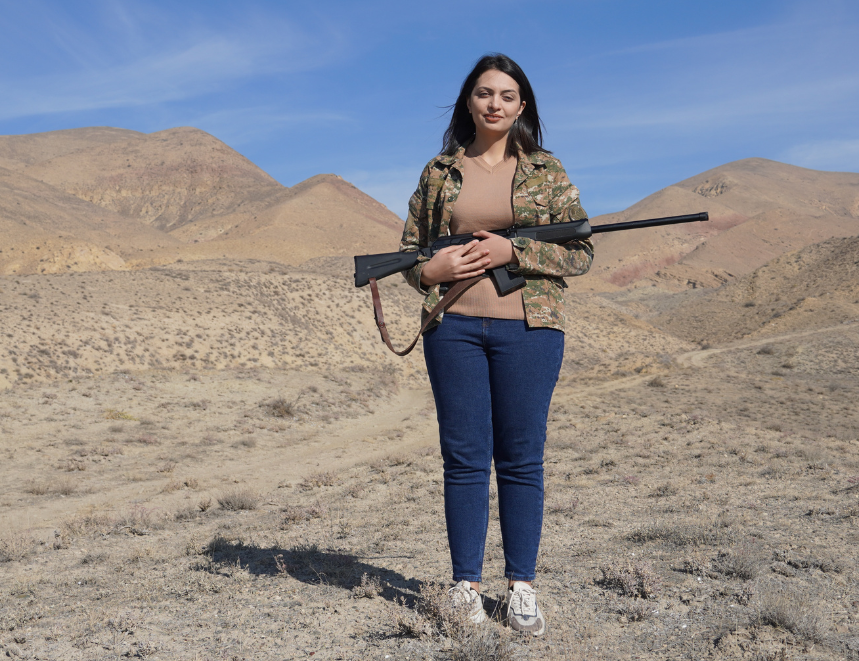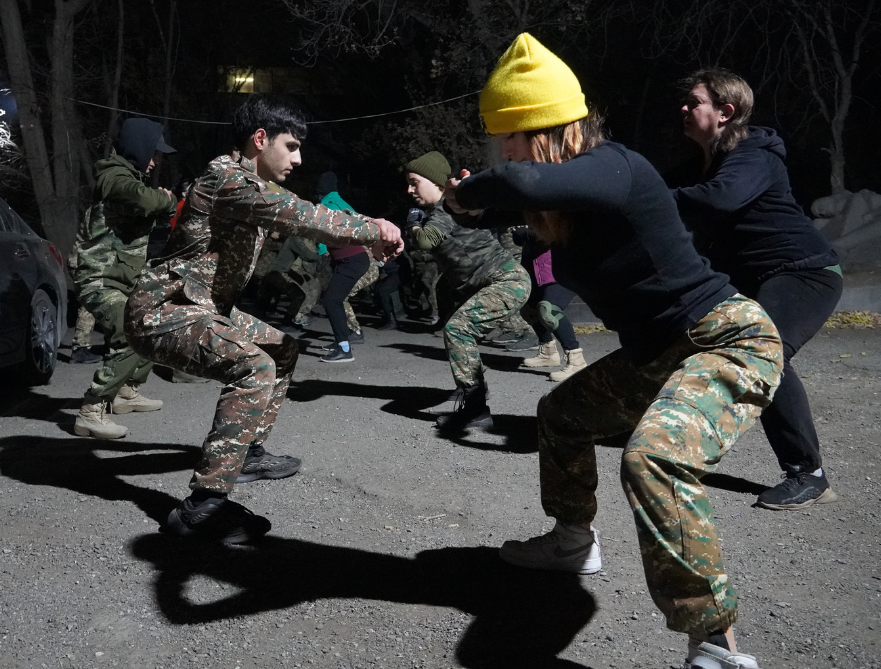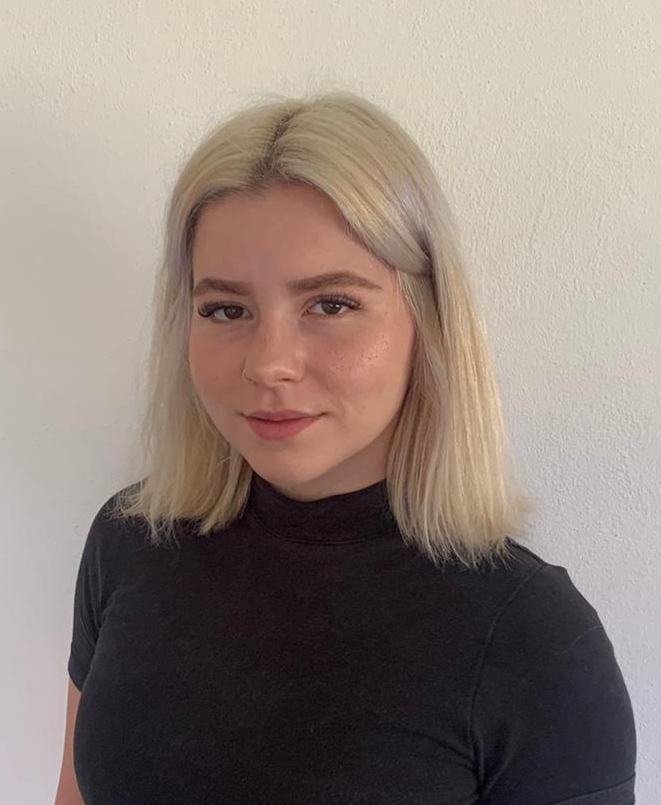Since Armenia lost the war against Azerbaijan in 2020, people no longer have any illusions about the strength of their own military. More and more Armenians – and especially Armenian women – are therefore training in case of a renewed escalation.
by Sarah Vojta
About 40 minutes by car south of the Armenian capital Yerevan, the road gradually turns into sandy hills. The barren nature here is almost untouched, the houses of the nearest village, Verin Dvin, are out of sight – and also out of earshot. That’s why Ani comes here almost every weekend to practice shooting with her father. The first time “when she was 14 or 15” and with hunting in mind, but now the 23-year-old woman is aware that she might have to aim her Kalashnikov at people one day.
Ani has owned the assault rifle for a year. “My first weapon,” she says as she takes it out of the safe at home, a small metal cabinet in which the family keeps two Russian-made assault rifles as well as cleaning materials and ammunition. The young woman shows how she inserts the cartridges. Clack, clack, clack – the metallic sound is heard ten times in routine quick succession before the magazine is full. She learned early on how to load and clean guns properly. “Things that are not dangerous for children.” For a year now, Ani has been going regularly to the sandy hills for shooting training; a pizza box with a bullet hole bears witness to the last visit.

Although weapons were always present in Ani’s family home, she has only been interested in them since the war two years ago. She is one of the country’s well-educated women, studied at the university in Yerevan, and works for an IT company in the capital. She almost went to Germany to study, Ani says with a laugh. Ani usually laughs when she says something and even when she holds her Kalashnikov in front of her chest, her demeanor has something childlike about it.
Then she turns around with the assault rifle still in her hand, goes down on one knee and loads the rifle by putting the magazine in. The young woman aims at the target about 100 meters away, unlocks and pulls the trigger. There is a loud bang, the cartridge case flies out of the barrel, sand and smoke swirl up next to the metal. Silence follows the bang. Then nine more times in quicker succession: Boom. Cartridge case. Smoke.
Armenia is reliant on self-defense
How does she feel with the camouflage jacket she wears over her everyday clothes? Stronger. And how does the gun makes her feel? More self-confident and strong. “Not towards other people without a gun. But when the time comes, I know what to do,” says Ani.
In September 2020 the dispute over control in the Nagorno-Karabakh region with Azerbaijan escalated. Only after 44 days and more than 6,500 deaths was a ceasefire agreement reached through Russian mediation. Since then, however, Armenians have been disappointed in their once reliable ally. No additional weapons were delivered, and President Vladimir Putin only sent soldiers afterwards in the form of “peacekeeping troops.”
More and more doubts are being raised in Armenia as to whether Russia is really interested in peace. People say “Putin is supplying expensive tanks to Azerbaijan and somewhat cheaper anti-tank missiles to Armenia,” because without the conflict he would lose an important means of exerting pressure in the region.
However, since the West, to which the Armenian government has repeatedly appealed, has so far held back with concessions, many Armenians feel dependent on Russia.
More and more women are being trained by militias
In order to be able to defend themselves in case of another war, more and more men and women are training in organizations like VOMA (an abbreviation meaning “Art of Survival” in Armenian). This public organization appeared in 2014, founded by a group of professional military and veterans, with the stated goal of creating a society capable of defending itself in war.
On their website, they write that the participants have different genders, beliefs and professions – the only important thing that unites them is that they “are all Armenians.” Along with learning how to use a gun, they also have to learn first aid and take part in a rigorous fitness program. The goal is to train 100,000 Armenians, given that the country has a population of almost three million.
This is because the ceasefire is broken almost daily; the last time the militia feared the worst was on September 13th of this year. Azerbaijani troops attacked during the night and their missiles also hit the spa town of Jermuk, which is far from the disputed region of Nagorno-Karabakh.
At that time, 25-year-old Marineh (name changed) had just started training with VOMA. She leads the way around the training grounds in the shadow of a building in soviet style on the outskirts of Yerevan. Men and women run panting over the circular track in the dark, most of them coming here after work and wearing at least one piece in camouflage. The former cinema next to it looks like a mixture of gym and barracks; next to the flag of Armenia hanging, one can notice that of the Republic of Nagorno-Karabakh.

Here, about twenty participants train how to handle assault rifles using wooden dummies, “to memorize the muscle movements,” Marineh explains. Slightly more than half of them are women.
“Many come here because of love,” says the young Armenian. “Most of the husbands, brothers and fathers have already fought in the war. More and more women want to support them next time.”
In the nation’s army, where every man has to serve, women are not accepted, which is another reason why they form the majority here. The tenor is always the same, no matter who you ask there: in case of war, Armenian women want to be able to defend themselves, their family and their country. “Everyone in Armenia has to be prepared.”
Ani was also trained by VOMA. When another escalation loomed in September, she was ready to go to the front line in Jermuk with a unit of the militia, she says. The first one had already left. The next one, which Ani wanted to go with, was not necessary because the fighting died down after two days. But the fear of a new escalation remains. And if the political situation does not change, Armenians could be left on their own again. Ani says: “In case of a war, I am prepared.”
This article was published within the frames of “Correspondents in Conflict” Project,
implemented by Yerevan Press Club and Deutsche Gesellschaft e. V. The Project is
funded by the German Federal Foreign Office within the “Eastern Partnership Program”.
The contents of this article are the sole responsibility of the implementing partners and can in
no way be taken to reflect the views of the Federal Foreign Office. #civilsocietycooperation
 Sarah Vojta works for the German media platform ZEIT ONLINE and as a freelance journalist. She also studies Russian and Social Sciences at Humboldt University in Berlin. In October and November of 2022, she went to Georgia for two months on an IJP scholarship. She is particularly interested in social and political developments in the post-Soviet space and feminism.
Sarah Vojta works for the German media platform ZEIT ONLINE and as a freelance journalist. She also studies Russian and Social Sciences at Humboldt University in Berlin. In October and November of 2022, she went to Georgia for two months on an IJP scholarship. She is particularly interested in social and political developments in the post-Soviet space and feminism.












